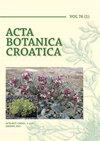Citruses in Croatia – cultivation, major virus and viroid threats and challenges
IF 0.7
4区 生物学
Q3 PLANT SCIENCES
引用次数: 2
Abstract
Although Croatia is not often perceived as a citrus growing country, citrus species have been planted in the Croatian southern coastal part for centuries. Citrus had always been important as a source of vitamins and micronutrients for local consumption, but with the introduction of Satsuma mandarins (Citrus unshiu Marc.) citrus production started its commercial development. The Croatian coast is probably the northernmost commercial citrus growing area globally with several agroecological constraints influencing citrus production. However, Satsuma mandarins, the most cold-tolerant citrus of economic interest, are successfully cultivated resulting in an excellent quality of fruits that easily finds a market niche. Unfortunately, with the import of plant material in the last century, the simultaneous introduction of viral and subviral pathogens occurred. The most important are Citrus tristeza virus and Citrus exocortis viroid. As certain rootstock-scion combinations are tolerant to virus or viroid infections and display no obvious symptoms, these pathogens have been continuously spreading by plant propagation. Molecular and biological analyses revealed the existence of pathotypes not believed to be endemically present in the Mediterranean region. Their high intra-isolate genetic variability and frequent coinfections suggest that this geographical region presents a sort of a biological enclave of potentially threatening pathogens. Their transmission from this agroecological niche to areas where sensitive rootstock-scion combinations are common presents a serious risk to citrus production, especially when global warming and the resulting migration of efficient vector species are considered. Comprehensive pathogen monitoring is important for improving citrus production and the prevention of pathogen transmission.克罗地亚的柠檬——种植、主要病毒和类病毒威胁和挑战
尽管克罗地亚通常不被视为柑橘种植国,但几个世纪以来,克罗地亚南部沿海地区一直种植柑橘。柑橘一直是当地消费的维生素和微量营养素的重要来源,但随着萨摩柑橘(Citrus unshuu Marc.)的推出,柑橘生产开始了商业发展。克罗地亚海岸可能是全球最北端的商业柑橘种植区,有几个农业生态限制因素影响柑橘生产。然而,最具经济价值的耐冷柑橘——温州蜜柑已经成功种植,其果实质量上乘,很容易找到市场定位。不幸的是,随着上个世纪植物材料的进口,同时引入了病毒和亚病毒病原体。最重要的是柑桔三体病毒和柑桔外果皮类病毒。由于某些砧木-接穗组合对病毒或类病毒感染具有耐受性,并且没有表现出明显的症状,这些病原体通过植物繁殖不断传播。分子和生物学分析显示,地中海地区存在一些不被认为是特有的病理类型。它们的高分离株内遗传变异性和频繁的共同感染表明,这个地理区域呈现出一种潜在威胁病原体的生物飞地。它们从这个农业生态位传播到敏感砧木-接穗组合常见的地区,对柑橘生产构成了严重风险,尤其是在考虑到全球变暖和由此导致的有效病媒物种迁移的情况下。病原体综合监测对提高柑橘产量和预防病原体传播具有重要意义。
本文章由计算机程序翻译,如有差异,请以英文原文为准。
求助全文
约1分钟内获得全文
求助全文
来源期刊

Acta Botanica Croatica
PLANT SCIENCES-
CiteScore
2.50
自引率
0.00%
发文量
34
审稿时长
>12 weeks
期刊介绍:
The interest of the journal is field (terrestrial and aquatic) and experimental botany (including microorganisms, plant viruses, bacteria, unicellular algae), from subcellular level to ecosystems. The attention of the Journal is aimed to the research of karstic areas of the southern Europe, karstic waters and the Adriatic Sea (Mediterranean).
 求助内容:
求助内容: 应助结果提醒方式:
应助结果提醒方式:


